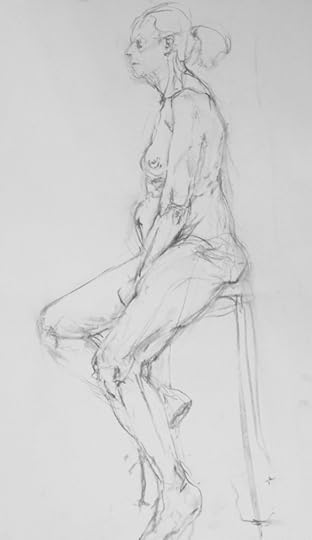Ask the Art Professor: What is the best way to simplify the human figure? As cubes or as spheres?

Welcome to “Ask the Art Professor“! Essentially an advice column for visual artists, this is your chance to ask me your questions about being an artist, the creative process, career advice, a technical question about a material, etc. Anything from the smallest technical question to the large and philosophical is welcome. I’ll do my best to provide a thorough, comprehensive answer to your question. Submit your question by emailing me at clara(at)claralieu.com, or by posting here on this blog. All questions will be posted anonymously. Read an archive of past articles here.
Here’s today’s question:
“What is the best way to simplify the human figure? As cubes or as spheres?”
The answer is neither. I see people all the time trying to reduce the human figure into a series of geometric shapes when they’re drawing from a live model. They draw spheres where there are joints (wrists, shoulders, elbows, etc.) and it always ends up looking like an awful mannequin. The problem with this approach is that cubes and spheres used in this manner have nothing to do with the actual anatomical structure and forms of the human figure.
When I teach figure drawing, I simplify the human figure into the three structural concepts listed below. If you draw the human figure with these structural concepts in mind, you’ll be pleasantly surprised that you’ll have a likeness of a figure in no time. The order of these structural concepts is important to maintain as well, as the largest forms are addressed first and then eventually working down into the smaller details.
1)Major Masses: Major masses are essentially the largest forms on the human figure. I recommend beginning a figure drawing by first addressing the torso, by far the largest form. The torso is where all of the limbs and the head intersect, so it’s critical to knock in the torso immediately when starting a figure drawing. The torso can then be subdivided into a ribcage and pelvis, which provides a sense of structure within the torso itself. From there, the head and thighs can be quickly added to provide more mass to the form. The limbs and the hands and feet should come in last.
2)Centerline: There is an imaginary centerline down the front of the torso and down the back of the torso. On the back of the torso, the centerline is easy to spot because it is basically the spine. On the front of the torso, the centerline starts at the pit of the neck, (the point in between the collarbones, aka clavicles) moves down the center of the rib cage, through the belly button down to the pubic bone on the pelvis. A centerline is highly descriptive of the type of pose that is being struck by a figure. Look at the centerline when a model is posing and ask yourself what the centerline is doing: is the centerline perfectly straight? Is it twisted, is it leaning to the right or left? If you quickly establish how the centerline is behaving in your figure drawing, you’ve won half the battle.
3)Boney Landmarks: Boney landmarks are areas on the human figure where the bone is directly under the surface of the skin. These landmarks are significant because they are consistent with every single person, regardless of how large or thin they may be. When you’re looking at a model, search for these boney landmarks and indicate them in your drawing. Some boney landmarks include: collar bones, elbows, kneecaps, ankle bones, shoulder blades, etc. Boney landmarks are considered to be details, so they should not be drawn in until the major masses and centerline are well established.
Related articles:
“What is a gesture drawing?”
“Is drawing considered an innate talent or a craft, which can be learned by anyone?”
“How can I learn to shade objects in my drawings?”
“How can I draw what I see in my head?”
“What is the best way to practice my drawing skills?”
“How can you learn to draw hair?”
“How do you get yourself to practice drawing?”





